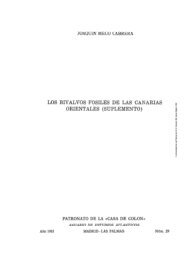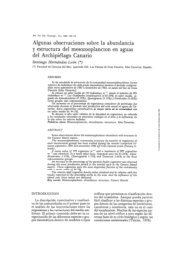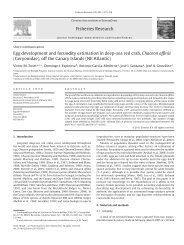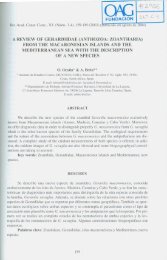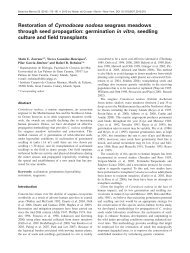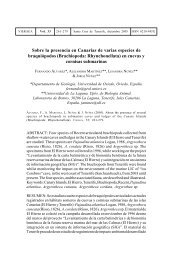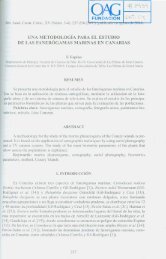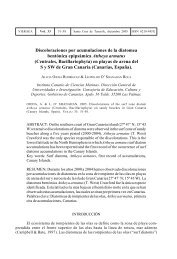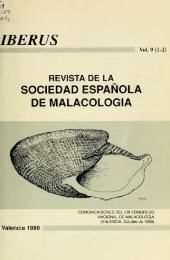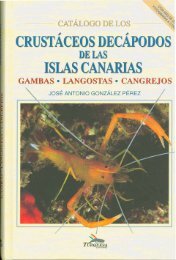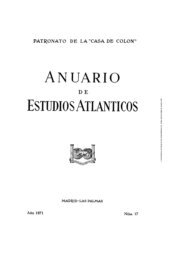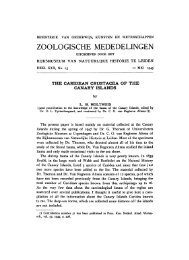of the madeira and selvagens archipelagos - redmic
of the madeira and selvagens archipelagos - redmic
of the madeira and selvagens archipelagos - redmic
Create successful ePaper yourself
Turn your PDF publications into a flip-book with our unique Google optimized e-Paper software.
S<br />
150<br />
125<br />
100<br />
75<br />
50<br />
25<br />
0<br />
1750<br />
1760<br />
1770<br />
1780<br />
Figura 5. Evolução do número de endemismos (S) da Madeira descritos desde 1753 até à actualidade, por década e valor<br />
acumulado.<br />
Figure 5. Trends in <strong>the</strong> description <strong>of</strong> endemic taxa (S) from <strong>the</strong> <strong>archipelagos</strong> <strong>of</strong> Madeira <strong>and</strong> Selvagens since 1753, with indication<br />
<strong>of</strong> <strong>the</strong> number <strong>of</strong> described taxa per decade <strong>and</strong> <strong>the</strong> cumulative number.<br />
ilhas de maior dimensão possuem maior número de endemismos<br />
exclusivos. Este padrão é no entanto quebrado<br />
pelas Selvagens, que possuem, em relação a este tipo de<br />
endemismos, maior número que as Desertas (Quadro 3). No<br />
que diz respeito ao Porto Santo, o número de endemismos<br />
é aparentemente inferior ao expectável, pois embora possua<br />
uma área total 3,2 vezes maior do que as Desertas (43<br />
Km 2 e 13,5 Km 2 , respectivamente), apenas possui mais um<br />
endemismo (38 e 37, respectivamente). Assim, o número de<br />
endemismos exclusivos reflecte não só dimensão mas também<br />
a distância em relação à ilha da Madeira. O número de<br />
endemismos partilhados em exclusividade por conjuntos de<br />
ilhas reflecte o mesmo padrão (Quadro 3). Em relação aos<br />
gr<strong>and</strong>es grupos taxonómicos, ressalta a presença de pteridófitos<br />
e gimnospérmicas endémicas exclusivas apenas da<br />
Madeira. A divisão em gr<strong>and</strong>es grupos reflecte o padrão geral<br />
das plantas vasculares, pois dominam em todas as ilhas<br />
e conjuntos de ilhas as dicotiledóneas (Magnoliopsida).<br />
A riqueza em taxa de plantas vasculares endémicas exclusivas<br />
pode ser relacionada com a área de cada uma das<br />
ilhas em que ocorre. Na Fig. 6 podem comparar -se o número<br />
e a densidade por 100 Km 2 de taxa endémicos exclusivos<br />
entre o arquipélago da Madeira, como um todo, e o<br />
das Selvagens, bem como entre estes e a Madeira, Porto<br />
Santo e Desertas. Verifica -se que, embora o número de endemismos<br />
aumente com a dimensão territorial das ilhas, a<br />
densidade dos mesmos diminui. Destaca -se o arquipélago<br />
das Selvagens por apresentar um número reduzido, mas<br />
uma elevada densidade de endemismos.<br />
Os dados que agora se publicam permitem uma comparação<br />
com os publicados para as Canárias (Acebes Ginovés<br />
et al. 2004; Martín et al. 2005), Cabo Verde (Sánchez-<br />
1790<br />
1800<br />
1810<br />
1820<br />
1830<br />
1840<br />
1850<br />
1860<br />
1870<br />
169<br />
1880<br />
1890<br />
1900<br />
Décadas (decades)<br />
1910<br />
1920<br />
1930<br />
1940<br />
1950<br />
1960<br />
exclusive endemics. However, <strong>the</strong> Selvagens are an exception<br />
to this pattern since <strong>the</strong>y harbour a larger number <strong>of</strong> exclusive<br />
endemics than <strong>the</strong> Desertas (Table 3). The number<br />
<strong>of</strong> endemics that occur in Porto Santo is apparently inferior<br />
to what could be expected, considering that this isl<strong>and</strong> is<br />
3.2 times larger than <strong>the</strong> Desertas (43 Km 2 <strong>and</strong> 13.5 Km 2<br />
respectively) <strong>and</strong> has only one more endemic taxa (38 <strong>and</strong><br />
37 respectively). So, <strong>the</strong> number <strong>of</strong> exclusive endemics is<br />
not only related to <strong>the</strong> surface area <strong>of</strong> <strong>the</strong> isl<strong>and</strong>, but also<br />
to <strong>the</strong> distance to Madeira Isl<strong>and</strong>. The number <strong>of</strong> endemics<br />
shared by groups <strong>of</strong> isl<strong>and</strong>s presents a similar pattern (Table<br />
3). For <strong>the</strong> higher taxonomic groups, Madeira is clearly<br />
dominant in number <strong>of</strong> exclusive endemic pteridophytes<br />
<strong>and</strong> gymnosperms. The dicotyledons (Magnoliopsida) are<br />
dominant in all isl<strong>and</strong>s <strong>and</strong> groups <strong>of</strong> isl<strong>and</strong>s following <strong>the</strong><br />
general pattern obtained for all <strong>the</strong> vascular plants.<br />
The richness in exclusive endemic vascular plant taxa<br />
can be related to <strong>the</strong> surface area <strong>of</strong> <strong>the</strong> isl<strong>and</strong>. Figure 6<br />
presents <strong>the</strong> number <strong>and</strong> density (per 100 Km 2 ) <strong>of</strong> exclusive<br />
endemic taxa for Madeira, Porto Santo, Desertas <strong>and</strong><br />
Selvagens, toge<strong>the</strong>r with <strong>the</strong> totals for <strong>the</strong> <strong>archipelagos</strong> <strong>of</strong><br />
Madeira <strong>and</strong> Selvagens. The figure shows that <strong>the</strong> number<br />
<strong>of</strong> endemics increases with <strong>the</strong> surface area <strong>of</strong> <strong>the</strong> isl<strong>and</strong>,<br />
but <strong>the</strong> density <strong>of</strong> endemics follows <strong>the</strong> opposite trend. The<br />
archipelago <strong>of</strong> Selvagens is unique for presenting few endemics<br />
but high density.<br />
The data presented here can be compared with published<br />
information from <strong>the</strong> Canary Isl<strong>and</strong>s (Acebes Ginovés<br />
et al. 2004; Martín et al. 2005), Cape Verde (Sánchez -Pinto<br />
et al. 2005) <strong>and</strong> Azores (Silva et al. 2005). Taking into consideration<br />
<strong>the</strong> need to make <strong>the</strong> categories <strong>of</strong> colonisation<br />
status used by <strong>the</strong> different authors compatible, it was as-<br />
1970<br />
1980<br />
1990<br />
2000<br />
2010



